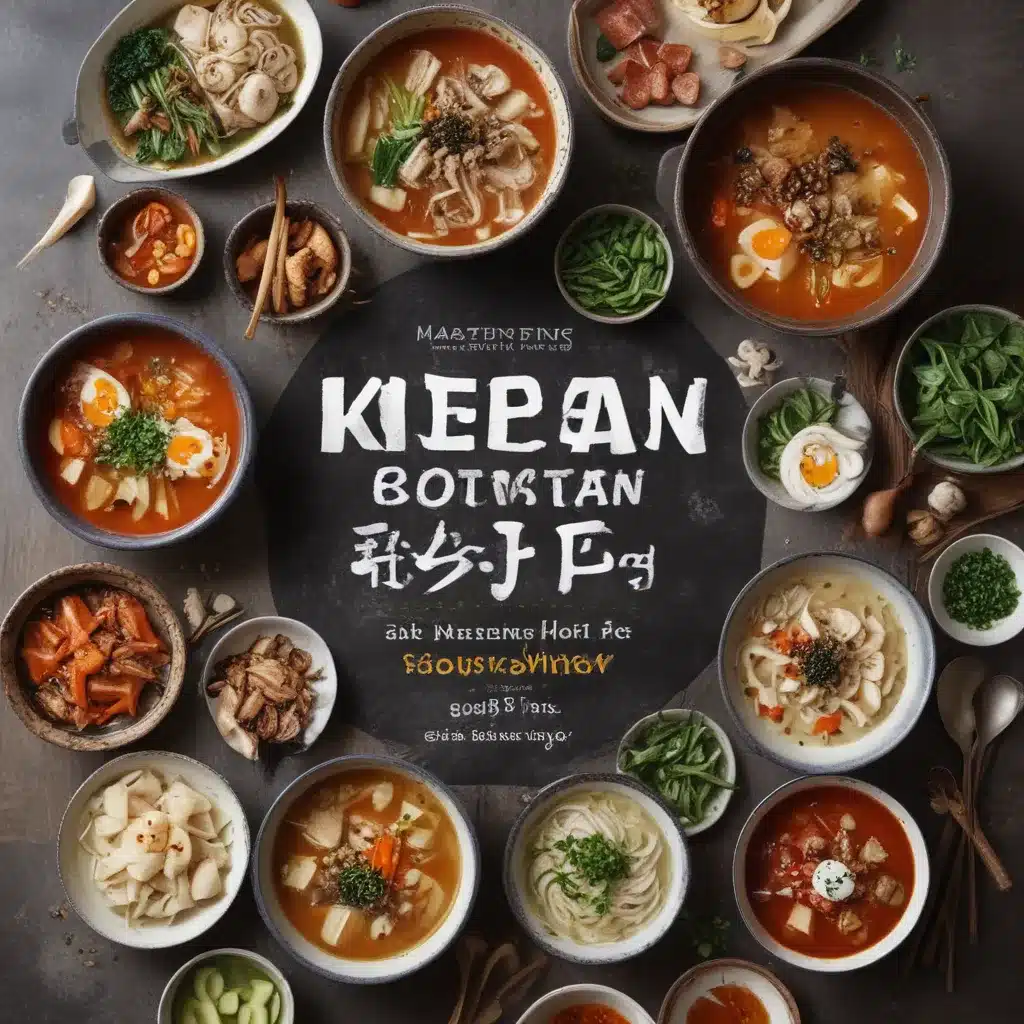
Diving into the Depths of Korean Culinary Wonders
As a self-proclaimed foodie traveler, I’ve had the privilege of exploring the diverse culinary landscapes of Asia. But you know what they say – you can take the girl out of Korea, but you can never take the Korea out of the girl. And when the cold winter winds start to blow, there’s nothing that warms my soul quite like the hearty, flavor-packed soups, stews, and hot pots of my heritage.
Growing up, I’ll admit I wasn’t always the biggest fan of these quintessential Korean dishes. As a child, I’d much rather have indulged in pasta, tacos, or frozen pizza than the funky, fermented flavors of doenjang jjigae or kimchi jjigae. It wasn’t until I started cooking for myself that I found myself craving those familiar tastes I had once so unwittingly taken for granted.
Embracing the Warmth of Korean Home Cooking
Now, as an adult, I can’t get enough of these warming, incredibly flavorful Korean staples. Whether it’s the earthy nuttiness of a hearty soybean paste stew or the fiery, funky heat of a bubbling pot of kimchi jjigae, these dishes have become a source of comfort and connection to my cultural roots.
It’s a journey I know I share with many others in the Korean diaspora. That’s why I’m thrilled to share my hard-earned expertise on mastering the art of Korean soups, stews, and hot pots. Because let’s be real – these dishes may seem intimidating at first, but with the right techniques and ingredients, they’re actually remarkably easy to prepare at home.
Unlocking the Secrets of Korean Flavor
One of the keys to achieving that authentic Korean flavor profile is learning to work with the right pantry staples. Things like gochugaru (Korean chili flakes), gochujang (fermented chili paste), and doenjang (soybean paste) may seem obscure at first, but they’re the building blocks of so many beloved Korean dishes.
And don’t even get me started on the wonders of Korean dashi – that umami-rich broth that forms the foundation for so many soups and stews. Once you master the art of coaxing maximum flavor from dried anchovies, kelp, and shiitake mushrooms, the possibilities are endless.
Mastering the Art of Korean Hot Pots
Of course, no exploration of Korean cuisine would be complete without delving into the world of Korean hot pots. These communal dining experiences are the stuff of legends, with bubbling broths, thinly sliced meats, and an array of fresh vegetables and noodles, all coming together for a truly interactive and immersive meal.
Whether you’re hosting a dinner party or just indulging in a cozy night in, a Korean hot pot is the perfect way to bring people together. And the best part? You don’t have to be a professional chef to pull it off. With a little guidance and the right equipment, you can transform your own dining table into a sizzling hot pot oasis.
Crafting Your Own Korean Culinary Adventure
So if you’re ready to dive headfirst into the captivating world of Korean soups, stews, and hot pots, buckle up. Because I’m about to take you on a culinary adventure that’s sure to tantalize your taste buds and warm your soul. Get ready to master the art of layering flavors, perfecting the balance of sweet, savory, and spicy, and discovering the joys of communal dining, Korean-style.
The journey may have its challenges, but trust me, the rewards are more than worth it. So let’s get started, shall we? Your new favorite Korean comfort food awaits.
Mastering the Fundamentals of Korean Soup and Stew Broth
At the heart of any great Korean soup or stew lies the broth – that rich, flavorful foundation that sets the stage for all the other ingredients to shine. And when it comes to crafting the perfect Korean broth, it’s all about harnessing the power of umami.
Enter the holy trinity of Korean dashi: dried anchovies, kelp, and shiitake mushrooms. These unassuming ingredients, when simmered together, transform into a liquid gold that’s bursting with savory depth. The key is to take your time, letting the flavors meld and mingle until you’ve achieved that perfect balance of briny, earthy, and subtly sweet.
But the fun doesn’t stop there. Once you’ve got your base broth dialed in, it’s time to start layering in those signature Korean flavors. A spoonful of gochujang for heat and complexity, a splash of soy sauce for saltiness, a touch of sugar for balance – it’s all about striking that perfect harmony.
And don’t be afraid to get creative. Maybe you want to add a few slices of fresh ginger for a little zing, or a sprinkle of toasted sesame seeds for nutty richness. The beauty of Korean cooking is that there’s no one-size-fits-all approach. It’s all about finding the flavors that speak to you and your own personal preferences.
Exploring the Diversity of Korean Stews and Hot Pots
Now that you’ve got the fundamentals of broth-making down, it’s time to dive into the wide world of Korean stews and hot pots. From the hearty, soulful doenjang jjigae to the fiery, funky kimchi jjigae, these dishes are the ultimate in comfort food.
But the best part? They’re remarkably easy to prepare at home, as long as you have the right ingredients on hand. Think thinly sliced meats, an array of fresh vegetables, and of course, those all-important Korean pantry staples.
And the beauty of these communal dining experiences is that they’re endlessly customizable. Don’t like tofu? Swap it out for tender chunks of beef or chicken. Prefer a milder flavor profile? Go easy on the gochujang. The possibilities are endless, and that’s what makes Korean hot pots so much fun.
But beyond just the flavors, there’s something truly special about the ritual of gathering around the table, carefully dipping and swishing your ingredients in the bubbling broth, and savoring every last bite. It’s a shared experience that brings people together, fostering conversation, laughter, and a deep appreciation for the power of good food.
Elevating Your Korean Culinary Repertoire
So whether you’re a seasoned Korean food enthusiast or a curious newcomer to this vibrant culinary landscape, I’m here to guide you on an unforgettable journey of mastering Korean soups, stews, and hot pots. With a little bit of know-how and a lot of passion, you’ll be whipping up restaurant-worthy dishes in no time.
But the real magic happens when you start to make these recipes your own, infusing them with your personal flair and favorite flavors. Because at the end of the day, the beauty of Korean cooking is in its ability to bring people together and create lasting memories.
So grab your chopsticks, fire up that portable burner, and get ready to dive into a world of simmering, bubbling, flavor-packed deliciousness. Your taste buds (and your soul) will thank you.
